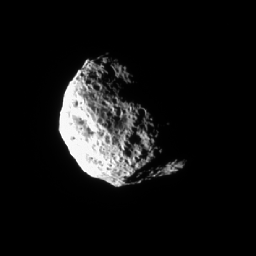
|
Rough and Tumble Hyperion (Movie)
- Click the image above for a larger view
 Movie Download Options
Movie Download Options- Full-Res JPEG (600 x 600) (14.9 kB)
- Full-Res TIFF (600 x 600) (372.7 kB)
Caption:
The tumbling and irregularly shaped moon Hyperion rotates away from the Cassini spacecraft in this movie taken during a distant encounter in Dec. 2005. A shadow closes over the large crater at bottom as the movie progresses.
Hyperion (280 kilometers, or 174 miles across) is covered with closely packed and deeply etched pits. The warming action of the Sun on water ice lying beneath a darkened layer of surface material apparently has deepened and exaggerated the depressions already created by impacts.
Cassini scientists now think that Hyperion's unusual appearance can be attributed to the fact that it has an unusually low density for such a large object, giving it weak surface gravity and high porosity. These characteristics help preserve the original shapes of Hyperion's craters by limiting the amount of impact ejecta coating the moon's surface. Impactors tend to make craters by compressing the surface material, rather than blasting it out. Further, Hyperion's weak gravity, and correspondingly low escape velocity, means that what little ejecta is produced has a good chance of escaping the moon altogether.
The movie was made from 40 images taken over about two hours as Cassini sped past the icy moon. A still image is also available (see PIA07684 ).
The images were taken in visible light with the Cassini spacecraft narrow-angle camera on Dec. 23, 2005 at distances ranging from 228,000 kilometers (142,000 miles) to 238,000 kilometers (148,000 miles) from Hyperion and at a Sun-Hyperion-spacecraft, or phase, angle ranging from 77 to 86 degrees. Resolution in the original images was about 1.4 kilometers (0.9 mile) per pixel. The images have been magnified by a factor of two and contrast-enhanced to aid visibility.
Note: The size of the Full-Res TIFF for the still image is 610 samples x 610 lines.
Background Info:
The Cassini-Huygens mission is a cooperative project of NASA, the European Space Agency and the Italian Space Agency. The Jet Propulsion Laboratory, a division of the California Institute of Technology in Pasadena, manages the mission for NASA's Science Mission Directorate, Washington, D.C. The Cassini orbiter and its two onboard cameras were designed, developed and assembled at JPL. The imaging operations center is based at the Space Science Institute in Boulder, Colo.
For more information about the Cassini-Huygens mission visit http://saturn.jpl.nasa.gov . The Cassini imaging team homepage is at http://ciclops.org .
Cataloging Keywords:
| Name | Value | Additional Values |
|---|---|---|
| Target | Hyperion | |
| System | Saturn | |
| Target Type | Satellite | |
| Mission | Cassini-Huygens | |
| Instrument Host | Cassini Orbiter | |
| Host Type | Orbiter | |
| Instrument | Imaging Science Subsystem (ISS) | |
| Detector | Narrow Angle Camera | |
| Extra Keywords | Color, Crater, Impact, Movie, Rotation, Shadow, Visual, Water | |
| Acquisition Date | ||
| Release Date | 2006-02-03 | |
| Date in Caption | 2005-12-23 | |
| Image Credit | NASA/JPL/Space Science Institute | |
| Source | photojournal.jpl.nasa.gov/catalog/PIA07683 | |
| Identifier | PIA07683 | |
